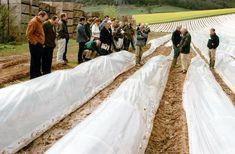
More than 130 members of the Asparagus Growers' Association last week heard their chairman Victor Aveling reveal that the traditional spring cut-off point of June 20-21 could be consigned to history, as a method of crown analysis developed initially in New Zealand is now being evaluated for use in the UK.
Aveling - recently returned from a NZ study tour - said research work on a product called ASPIRE will be complete in two years. "There is evidence that growers will be able to carry out the procedures themselves," he added.
ASPIRE detects and calculates the level of carbohydrate in asparagus crowns which provides the energy necessary for the spears to grow.
Accurate assessment would create a better understanding of the crop's potential, which could lead to yields being increased beyond the industry average of 1.5 tonnes an acre. The information could also be used to identify a longer harvesting period.
The AGA's open day, at Cobrey Farms, near Ross-on-Wye, was also the occasion for the official opening of Cobrey's new £700,000 packhouse and coldstores, by Sally Green, Defra's area manager for the West Midlands.
Under the rural development scheme, the project qualified for 33 per cent grant aid, and was built adjacent to the company’s potato packhouse over a five-month period.
Cobrey supplied its first gras of the season to Marks & Spencer on March 26, and also supplies Tesco, Sainsbury’s and Morrisons, so AGA members were able to see the new grading and trimming machine in action.
The packhouse handles about half of Cobrey's potential production, and by 2007 will reach full summer capacity, handling the 140 hectares of asparagus coming on stream. Discussions are already taking place about Phase II, as the building has been designed to take four graders.
The existing German-built Strauss optical grading line takes three images of each spear, to measure length, diameter and quality. The machine has seven knives, evenly spaced out between 129 chutes, which trim off each spear according to its size, minimising waste and maximising the Class I packout. Weight is calculated on the density value of each spear and, according to one of 20 specifications, each bunch is delivered to the packer for quality control and packing.
John Chinn, Cobrey Farms managing director, has spent the last three seasons planting proven gras varieties such as Gynlim, conventional and organic, Backlim and Jersey Giant. There are also trials of a purple variety. Data on the crop is being gathered by constant monitoring the effect of soil and air temperatures, which Chinn believes will bring greater understanding of production.
With heavier yields and longer seasons on the horizon - reflected in the AGA's estimate that there are 25 per cent more crowns in the ground to be harvested this year - Aveling holds a confident outlook.
"English asparagus is recognised by retailers as a superior product, which enjoys a reputation for quality and seasonality,” he said. “Supermarkets have really got behind the product .
“There was a time when production was limited by the amount of labour that was available, but this has now changed and there is enough labour to expand."
This is not a question of luck, he stressed. For the past three years the AGA has invested in a voluntarily-funded promotional campaign, which this season has attracted greater support from members. Six subscribers contribute a total of £30,000 annually; they are Barfoots, Bomfords, Exotic Farm Produce, Kitchen Garden Produce, Mack and Tuddenham Hall.
Aveling admits he would still like others to share the cost, but said: "We saw greater volumes coming and acted accordingly, rather than wait," he explained. "The result is that this year we should still be able to sell all we produce."
What encourages AGA is that figures from market analyst TNS show that market penetration is increasing. Pam Lloyd, agency account executive at BCLO, said that last May, volumes year-on-year were up 25.5 per cent by volume (448t) and 39.9 per cent by value (£3.54 million). June showed a similar volume increase (413t ) and a 35.7 per cent value rise (£3.33m). "This meant that 29 per cent more consumers were buying asparagus,” she added.
The target for the AGA promotional effort this year, said Lloyd, is initially to highlight the arrival of the crop - something which has already received considerable coverage in the national media, as supermarkets "raced " to be first.
As availability increases, radio interviews are planned for April 27, and there will be sample drops at radio stations in the first week of May.
There is also the potential of a new untapped market in the foodservice industry, according to David Burns, commercial director of Redbridge Caterfresh. He estimated that while fresh fruit and vegetable requirements are expanding fast in the burgeoning sector, asparagus is being left behind.
"Fruit and vegetable sales in the sector rose by £24m last year, to £420m," he said. The asparagus spend was probably less than £2m.
"Foodservice actually has a higher loyalty factor than that shown by retailers," he claimed. "This market will continue to grow and offer a real alternative.
"One way of taking advantage of this trend would be to consider the development of a quality brand like Jersey Royal, and consider fit-for-purpose grading outside the industry norms,” he suggested.



